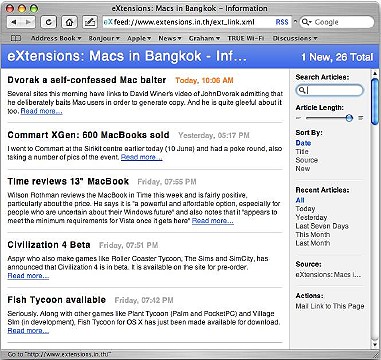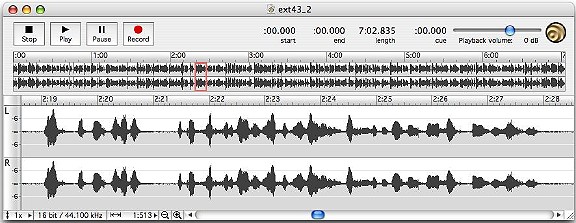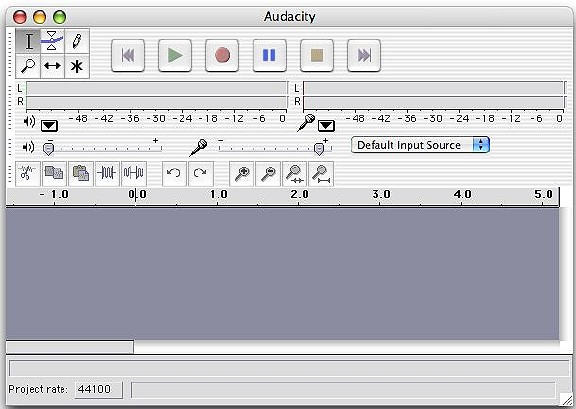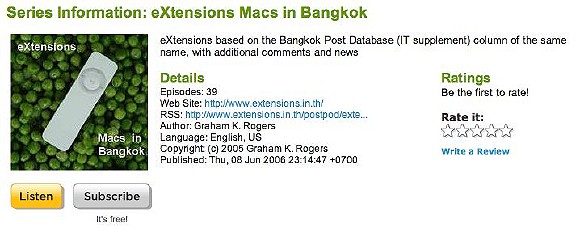eXtensions
|
RSS: Reaching Sophomore Students |
![]() I had hoped that students I teach this year would have some knowlege of recent technology particularly Really Simple Syndication or RSS. When it became clear that there was a gap, I had to go back to basics. Teachers should not presume.
I had hoped that students I teach this year would have some knowlege of recent technology particularly Really Simple Syndication or RSS. When it became clear that there was a gap, I had to go back to basics. Teachers should not presume.
I have been making a weekly podcast, based on the eXtensions column, for several months and (at the time of publication) number 45 is current. I had three motivations: to put the column in another format; to make that format accessible to non-native speakers of English; and to add other information concerning Macs. (To access the podcast, type www.extensions.in.th/postpod/extensions.xml in a suitable application.)
I also have a newsfeed for my eXtensions website that informs anyone who links to it about new items on the site, and about anything else I find interesting concerning Macs, OS X and Information Technology in general. Many good newspapers have RSS feeds.
I already communicate with the students via e-mail and, after an experiment last semester, I have decided to use a course newsfeed as an alternative: to update them with items I think should interest them. As I want the students to have access to other English media, I added a podcast. Like the eXtensions podcast, it is made on the simplest equipment: to show it can be done; and because I have limited resources.
The students were aware what HTML was for; but not what it signified (hypertext markup language). I also discovered that they knew nothing of RSS newsfeeds, podcasts, nor the extensible markup language (XML) that makes them and blogs (the web log) possible. We did establish that the iPod was a type of MP3 player and they were happy with that.
Other university lecturers, particularly in the US and UK, are also beginning to use the podcast as a way to communicate with students, although I do not think it is a substitute for the classroom. I am trying to encourage some of my colleagues to use the medium: the best way is to start the ball rolling myself.
As most of my students use Internet Explorer, they cannot subscribe to a newsfeed. I told them to download a news feed reader or to use the latest Firefox. A Google search of "news feed reader+Windows" produces several links. One student (a voice in the wilderness) has an iBook so can use Safari, although he too had never tried this.

Safari displays a blue RSS symbol in the address panel when a link is available. Clicking on this icon displays the RSS feed in the browser page. It is not until the user clicks on "Subscribe" that the link is permanently accessed.

In Firefox a link that has an RSS feed link will display an orange "broadcast" symbol in the URL panel. Microsoft will also use this icon in IE7 and Outlook 12; Opera too. If a user clicks on that icon, Firefox offers to "Add Live Bookmark". It is good practice to manage bookmark folders with care: you do not want all feeds in one location.
Unlike HTML, I find XML difficult to write and use software for the purpose. For newsfeeds, I have FeedForAll, which runs on OS X and Windows. For the podcasts, I use "Podcaster RSS Buddy".

I use the sound input from the PowerBook. This is simple but quality suffers. I record in mono using Sound Studio, a shareware application bundled with Macs at one time. I have also the Open Source application, Audacity, which is a fairly sophisticated utility, well-suited to creating podcasts as well as other more complex recording tasks.

For the eXtensions podcast, I use my column (although I have to adapt this while recording) and news that I jot down during the week. I also include local information when possible, and new tricks found while using my own Macs, I add those if appropriate.
I take a similar approach with the student podcast. Again, I use the eXtensions column as main input: if students are interested they can read and listen at the same time. I add useful local and international news; and I also make some comments on the class.
I edit the mono sound then resample into stereo. I drag the file into GarageBand where I add music and jingles (sparingly). I then export to iTunes where the AIFF file is converted to MP3, and add what Apple calls, "Artwork." I try to make the sound files 15 - 19 minutes each.
The converted file uploaded, along with the XML file, to the website. If the correct URL is used in iTunes or other suitable software, files are downloaded automatically. The file will also appear in some browsers (Firefox may need a plug-in) and can also be found on the Yahoo! podcast site as well as at the iTunes shop (free downloads).


For further information, e-mail to
Back to
eXtensions
To
eXtensions: 2004-05
To
eXtensions: Year Two
To
eXtensions: Year One
To
eXtensions: Book Reviews
Back to homepage